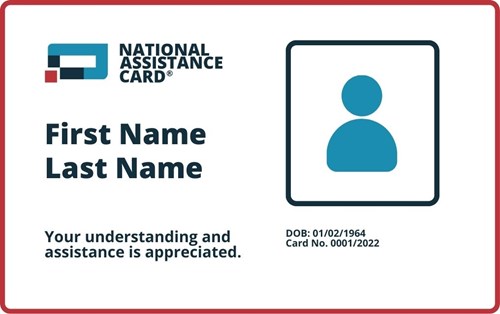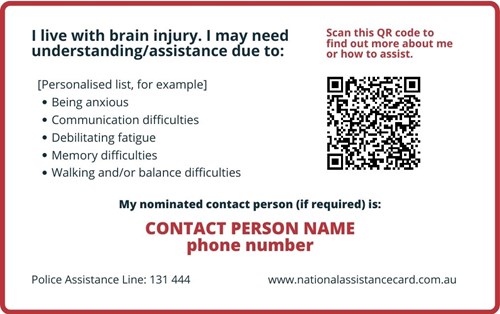National Assistance Card
Survivors of childhood stroke can live with lasting disabilities that can make everyday interactions and activities challenging for both them and their families. The National Assistance Card is designed to help bridge this gap. It is a simple tool to communicate your child's needs effectively in different situations.

What is the National Assistance Card?
The National Assistance Card is a personalised card that provides essential information about a person’s disability. It includes specific details to help others understand how to offer assistance or accommodations. For childhood survivors of stroke, this can include physical, cognitive, and emotional needs. The card can be used in everyday or emergency situations where a cardholder needs assistance or support.
The National Assistance Card can:
- Enhance Communication: The card provides a straightforward way to communicate complex information about the child’s needs. It can reduce parents and children having to explain their condition repeatedly.
- Increase Independence: By having a clear, concise tool to convey their needs, children can navigate environments more independently and confidently.
- Improve Understanding: The card helps foster a better understanding and awareness of invisible disabilities among the public, promoting empathy and inclusivity.
- Reduced Stress: For both the child and their family, the card minimises misunderstandings and the stress associated with explaining or justifying needs.

“The National Assistance Card has been a game changer for me. It has given me the confidence and reassurance to go out and access the community to the best of my abilities, independently. One of the main reasons I find this card is so helpful is because of my medical-based PTSD. In the past, I would faint during medical appointments when I became overwhelmed or triggered. This made me hesitant to attend appointments alone. I worried about people jumping to conclusions or having to explain my needs while in a heightened state. Since getting the National Assistance Card, I no longer have to worry about these things. It has given me peace of mind and the power to choose who I share my private medical information with. I no longer have to explain everything in a busy waiting room, and I can attend my appointments alone without any concerns. This card truly empowers me to live my life to the fullest.” - Hailey, survivor of childhood stroke
How can the National Assistance Card be used?
The National Assistance Card can be used in different settings to support survivors of childhood stroke. The card is particularly beneficial for children who may find it challenging to articulate their own needs. Here’s how families can use the card to support their child:
- School Environment: The card can be shared with teachers, aides, and school administrators to ensure they understand your child's unique needs. This helps ensure your child receives necessary support such as adjustments in classroom activities, seating arrangements, regular breaks, extra time for exams or assistance with physical tasks.
- Social Situations: During playdates, birthday parties, or other social events, the card can be given to other parents or guardians to help them understand any special requirements or potential behaviours that need consideration.
- Healthcare Settings: During hospital visits, doctor appointments, or therapy sessions, the card provides healthcare professionals with quick insights into your child’s condition, ensuring that the appropriate care and communication methods are used.
- Extracurricular Activities: The card can be used in sports, clubs, or other group activities, to help coaches and leaders understand your child’s condition and offer the necessary support to ensure full participation and enjoyment.
- Recreational Activities: At places like amusement parks, museums, or swimming pools, the card can be used to request accommodations such as skipping long lines, finding quiet areas, or getting special seating arrangements.
- Transport: When using transport such as airports, buses, trains, trams, taxis and Ubers. The card can be shown to staff to request priority seating, assistance, or other necessary accommodations without repeatedly explaining the condition.
- Emergency Situations: In the event of an emergency, the card provides first responders with immediate knowledge of your child’s condition, guiding them on how to handle the situation with your child’s specific needs in mind.
What does the National Assistance Card include?
The National Assistance Card includes a cardholder's:
- first and last name
- photo
- date of birth
- nominated contact person's name and phone number
(A cardholder can choose if this person is contacted).
Also printed on the card:
- up to five areas of difficulty chosen by the cardholder. For example, communication, fatigue, memory, processing information.
- a QR code providing access to additional information (written or personalised video) that the cardholder has chosen to include.
- the Police Assistance Line phone number.
What does the National Assistance Card look like?


Scan the QR code to view an example of additional written and video information.
How do I apply for the National Assistance Card?
To apply for a National Assistance Card please visit: www.nationalassistancecard.com.au/apply
To help you with your application we recommend you:
- Read one of the How to Apply Guides. You can refer to these Guides while you complete your application.
- Watch the ‘How to’ videos included in the application, such as the overview video.
A new National Assistance Card costs $44. This cost can be claimed on NDIS.
If you have any questions about the National Assistance Card, please:
- Visit the National Assistance Card Website, you may find the answer
you need on the Frequently Asked Questions page:
www.nationalassistancecard.com.au/frequently-asked-questions - Contact the National Assistance Card Team via:
Email: info@nationalassistancecard.com.au or
Phone: freecall 1300 242 827
What should you include in the additional information viewed through the QR code?
You can include as little or as much information as you feel comfortable. It can be written or in a video. Here's an example:
Hello, my name is ..........
If I am giving you this card it is because it is important for you to know I have had a stroke, and my brain works differently. I may need understanding/assistance due to:
- Communication difficulties
- Attention/concentration difficulties
- Confusion/disorientation
- Debilitating fatigue
- Difficulty controlling my emotions
- Difficulty following instructions
- Difficulty standing for long periods
- Difficulty with changes in routine
- Difficulty with social cues/interactions
- Memory difficulties
- Feeling anxious
- Feeling overwhelmed
- Reading difficulties
- Seizures
- Slow response time
- Walking and/or balance difficulties
What this means for me/How you can assist me:
- I might look okay, but I am not. This does not define me.
- I am just as intelligent as you. I just have memory and recall difficulties. With a bit of patience, I usually remember the thread of what's going on.
- I have word finding difficulties especially when I'm tired. If I have difficulties communicating, please give me extra time to speak.
